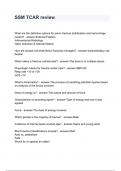NHA Certified Clinical Medical Assistant (CCMA)
Detailed Test Plan*
150 scored items, 30
pretest Exam Time: 3 hours
*Based on the Results a Job Analysis Study Completed in 2016
This document provides an outline of the topics and associated weighting that may be
covered on the CCMA Certification Exam. A one-page summary of the plan is also
available.
Within a given topic area, task and/or knowledge statements will be provided.
Knowledge statements reflect information that a candidate will need to know, while
task statements reflect duties that a candidate will need to know how to properly
perform. Items on the exam may require recall and critical thinking pertaining to a
knowledge statement, a task statement, or both.
Please note that some domains only contain knowledge statements.
1. Foundational Knowledge and Basic Science
Knowledge of:
A. Health care systems and settings
1. Role and responsibilities of the MA, other healthcare providers, and
allied health personnel
2. Scope of practice
3. Titles and credentials
4. Licensing and certification
5. Healthcare delivery models (HMOs, PPOs, POS, PCMH, accountable
care organizations/payment for performance [ACOs], hospice,
collaborative care model)
6. General versus specialties and services offered
7. Ancillary services; alternative therapies
, 8. Insurance fundamentals
B. Medical terminology
1. Common abbreviations, acronyms, and symbols
2. Conditions, procedures, and instruments
3. Medical word building (prefixes, suffixes, plurals)
4. Positional and directional terminology
C. Basic pharmacology
1. Commonly prescribed medications and common approved
abbreviations
2. Drug classifications and drug schedules
3. Side effects, adverse effects, indications, and contra-indications
4. Measurement (for both metric and household systems),
mathematical conversions, and dosage calculations
5. Forms of medication (for example, pill, capsule, ointment)
6. Look alike/sound alike medications
7. Routes of administration
8. Pharmacokinetics (absorption, distribution, metabolism, excretion)
9. Rights of drugs/medication administration
10. Physicians' Desk Reference and online resources
11. Principles of storage and disposal
D. Nutrition
1. Dietary nutrients
2. Dietary needs and patient education (general, and related to
diseases and conditions)
3. Vitamins and supplements
4. Eating disorders
5. Food labels
, E. Psychology
1. Developmental stages
2. End-of-life and stages of grief
3. Psychology of the physically disabled, developmentally delayed,
and those with diseases
4. Environmental and socio-economic stressors
5. Mental health screening
6. Defense mechanisms
2. Anatomy and Physiology
Knowledge of:
A. Body structures and organ systems
1. Anatomical structures, locations, and positions
2. Structure and function of major body systems, including organs and
their locations
3. Interactions between organ systems, homeostasis
B. Pathophysiology and disease processes
1. Signs, symptoms, and etiology of common diseases, conditions, and
injuries
2. Diagnostic measures and treatment modalities
3. Incidence, prevalence, and risk factors
4. Risk factors leading to high mortality and morbidity (for example,
complications, accompanying diseases)
5. Epidemics and pandemics
C. Microbiology
1. Cell structure (for example, nucleus, cell wall, cell membrane,
cytoplasm, ribosomes, mitochondria, lysosomes, nucleolus)
2. Common pathogens and non-pathogens
3. Organisms and microorganisms






